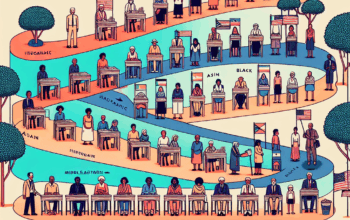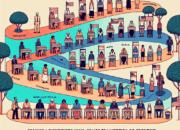Introduction
Grassroots movements have emerged as a powerful force in shaping democratic practices around the globe. As political landscapes evolve and citizens become increasingly dissenting, the influence of grassroots initiatives in mobilizing communities and advocating for change cannot be overstated. In 2025, these movements have taken on new dimensions, utilizing technology and social media to amplify their messages and reach diverse audiences. This article explores how grassroots movements strengthen democratic practices, examining their roles, strategies, and significant impacts on political engagement, policy change, and social cohesion.
The Power of Grassroots Movements in Democratic Engagement
Grassroots movements are often defined by their organic, community-driven nature. At their core, these initiatives draw their strength from the collective will and participation of ordinary citizens. In 2025, they continue to serve as catalysts for democratic engagement, empowering individuals to take ownership of the political process. The grassroots approach encourages people to voice their opinions, share their experiences, and actively participate in decision-making processes that affect their lives. With inclusivity as a hallmark, these movements have been instrumental in mobilizing marginalized voices that are often overlooked by traditional political structures.
In a political climate marked by polarization and disillusionment, grassroots movements foster a renewed sense of hope and engagement. By focusing on local issues—such as police reform, environmental justice, and education equity—activists tap into the immediate concerns of their communities, thereby enhancing civic participation. In 2025, many grassroots organizations leverage technology to host virtual town halls, online petitions, and social media campaigns, thus ensuring broader outreach and bringing people together despite geographical barriers. Through these methods, grassroots movements not only cultivate democratic practices but also foster a culture of active citizenship.
The Role of Technology in Grassroots Movements
In the digital age, technology has become a significant ally of grassroots movements, elevating their ability to mobilize, organize, and inform. Social media platforms are now the primary means for grassroots organizations to reach vast audiences quickly and efficiently. For instance, in 2025, movements addressing climate change and social justice have employed sophisticated digital strategies to harness the power of virality, resulting in massive online mobilizations that have transitioned into real-world activism. Hashtags and viral challenges are often used to articulate messages succinctly and resonate with audiences, ensuring that issues are not just heard but also engaged with on a personal level.
Furthermore, data analytics and online tools allow these movements to target specific demographics effectively. By understanding the needs and concerns of various community segments, movements can tailor their messages and strategies accordingly. In many cases, grassroots organizations utilize crowdfunding platforms to finance local initiatives, ensuring that their voices remain independent of corporate interests or political affiliations. In 2025, the widespread use of apps designed for civic engagement—like organizing events or notifying local representatives—has transformed how movements operate. These innovations are central to deepening democratic practices by empowering citizens to act collectively, creating an ecosystem that values participatory governance and accountability.
Grassroots Movements and Policy Change
One of the most significant impacts of grassroots movements lies in their ability to influence policy change. Throughout history, many landmark policies have emerged from grassroots protests and advocacy campaigns. In 2025, we witness a resurgence of demands for comprehensive immigration reform, climate action, and social equity—issues largely championed by grassroots organizations. Utilizing a combination of on-the-ground activism and strategic partnerships with local officials, these movements have successfully advocated for nuanced policies that reflect the collective demands of their constituents.
Central to the success of these movements is their ability to frame issues in ways that resonate with both policymakers and the public. Grassroots organizations often employ storytelling and personal testimonies to illustrate the urgency of their causes. For example, through compelling narratives shared on social media, they depict the real-life implications of climate inaction or systemic discrimination, thus rallying broader support for policy shifts. As citizens mobilize around these narratives, policymakers are increasingly compelled to consider public sentiment when crafting legislation. In 2025, we see policymakers more attuned to grassroots feedback, acknowledging their influence on public discourse and legislative agendas.
Moreover, grassroots movements often serve as incubators for future political leaders. Many elected officials find their initial support and inspiration from grassroots activism. With movements that encourage leadership development, skills training, and networking opportunities, they provide the foundation for a new generation of politicians committed to serving their communities. In this way, grassroots movements not only advocate for change but also cultivate democratic principles by nurturing individuals who will champion these ideals within political institutions.
The Importance of Inclusivity and Diversity in Grassroots Movements
Inclusivity is vital for the effectiveness and longevity of grassroots movements. In 2025, many organizations recognize that a diverse coalition strengthens their capacity to address complex social issues. By including voices from various backgrounds—such as racial and ethnic minorities, women, LGBTQ+ individuals, and people with disabilities—grassroots movements create a more comprehensive understanding of the challenges facing communities. This diversity enables movements to propose solutions that are equitable and representative of the broader population.
Additionally, inclusivity fosters resilience within grassroots movements. When individuals from different backgrounds unite for common goals, they enrich the discussion and promote creativity in problem-solving. Diverse coalitions are better equipped to navigate challenges and adapt to evolving political contexts. In 2025, we observe movements that prioritize intersectionality, recognizing that issues such as gender inequality cannot be disentangled from climate justice or racial equity. This multidimensional approach underscores the significance of inclusivity as a means of strengthening democratic practices, ensuring that no voice is left behind.
Furthermore, as grassroots movements champion inclusivity, they foster social cohesion within communities. By promoting dialogue and understanding among diverse groups, they contribute to a more harmonious society. Engagement in grassroots activism cultivates empathy and collaboration, encouraging individuals to see beyond their personal experiences. This communal spirit underscores the essence of democracy: a collective commitment to the well-being of all citizens. In 2025, the continued emphasis on inclusivity within grassroots movements serves as a crucial reminder that democracy flourishes when everyone participates.
The Future of Grassroots Movements in Strengthening Democracy
As we look to the future, grassroots movements will undeniably continue to play a pivotal role in shaping democratic practices. In the face of global challenges such as climate change, economic inequality, and political corruption, these movements offer innovative solutions rooted in local knowledge and community engagement. The evolving landscape of political communication, driven by advances in technology, will empower grassroots organizations to adapt and mobilize more effectively than ever before. For instance, as artificial intelligence (AI) tools become more commonplace, grassroots movements can harness data to target their messaging and outreach, cultivating informed and engaged citizenry.
Looking ahead, the integration of environmental, social, and governance (ESG) principles into grassroots activism presents an exciting frontier. In 2025, the growing recognition of the interconnectedness of societal issues fosters collaborations among movements committed to racial justice, environmental sustainability, and economic equity. This synergistic approach allows grassroots organizations to amplify their reach and impact by uniting their efforts toward shared objectives. As these coalitions grow, they will likely exert significant influence over legislative bodies and institutional practices, reinforcing democratic accountability.
Ultimately, the future of grassroots movements hinges on their ability to adapt and innovate while remaining grounded in community values. As challenges evolve and new issues arise, these movements must remain responsive to the ever-changing political landscape. By nurturing democratic principles and engaging citizens at every level, grassroots movements will continue to empower individuals and enhance the quality of democracy. The resilience and adaptability displayed by grassroots organizations will shape the democratic landscape of 2025 and beyond, ensuring that the voices of the many are heard and acted upon.
Conclusion
Grassroots movements play a vital role in strengthening democratic practices by empowering citizens, influencing policy change, fostering inclusivity, and adapting to future challenges. As we progress through 2025, these movements will continue to influence political engagement, mobilizing communities to advocate for local concerns and drive meaningful change. By prioritizing inclusivity and leveraging technology, grassroots organizations are redefining what it means to participate in democracy. As a result, they are not just advocating for policies but also cultivating a culture of active citizenship, critical dialogue, and collaborative problem-solving that is essential for a robust democracy.
FAQs
What are grassroots movements?
Grassroots movements are community organizing efforts driven by ordinary citizens aimed at addressing local or national issues. These movements emphasize the participation and engagement of individuals who often mobilize collectively to enact social, political, or environmental change.
How do grassroots movements influence policy change?
Grassroots movements influence policy change by mobilizing public support, advocating through protests and campaigns, and engaging with lawmakers to ensure that local issues are addressed in legislation. They often use storytelling and personal testimonies to illustrate the urgency and necessity of specific policy reforms.
Why is inclusivity important in grassroots movements?
Inclusivity enriches grassroots movements by ensuring that diverse voices and perspectives are represented, leading to more equitable and comprehensive solutions. It fosters social cohesion and resilience within communities, ultimately strengthening the democratic process.
What role does technology play in grassroots movements today?
In the digital age, technology facilitates communication, outreach, and organization for grassroots movements. Social media, data analytics, and online tools enhance their ability to mobilize supporters, educate the public, and advocate for change effectively.
How can individuals get involved in grassroots movements?
Individuals can get involved in grassroots movements by volunteering their time, participating in local events, signing petitions, advocating on social media, and donating resources. Engaging with local organizations focused on community issues is a great starting point.












